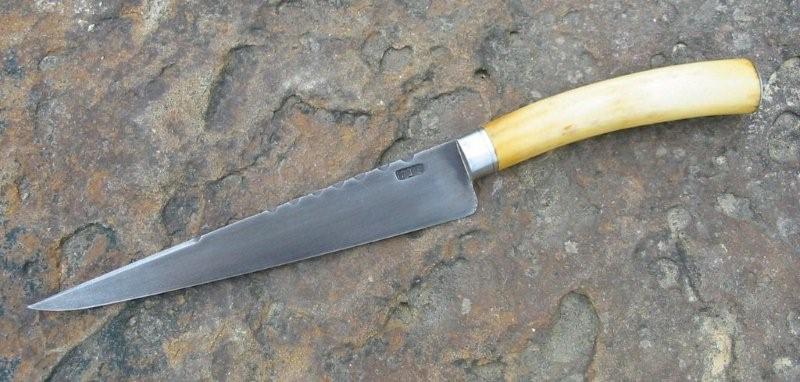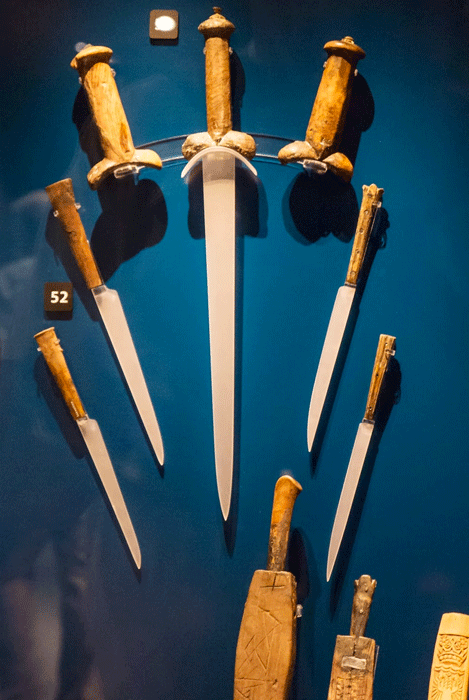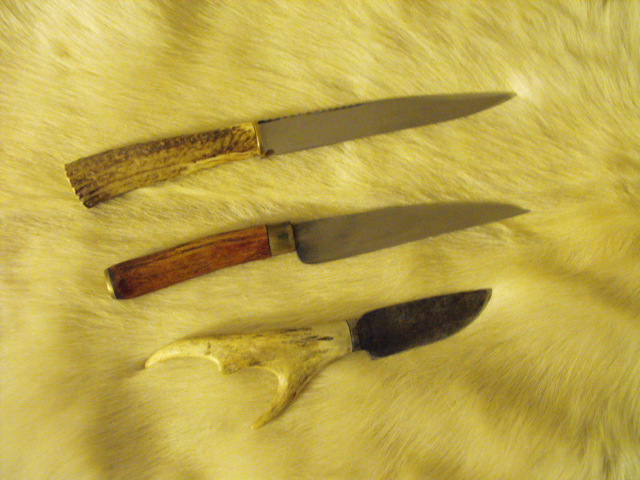I was wondering if the scottish had a heavy work knife comparable to the bowie knife or the kukri in the time period between 1000 - 1800 ad. I figure that with them being mercenaries and a few clans such as the macloeds having direct viking descent seaxs might have been a thing. So in short were seax knives common in scotland or was there another working tool like the kukri and bowie.
Well you have a fairly long time period your working with here, so narrowing it down a to a particular century would help. As far as distinctive Scottish knives, they don't really show up until the 16th century. Apart from this you could use pretty much any style of knife that was used elsewhere in Europe for the appropriate time period. As for seaxes I would say that you would be safe in using them up to about 1200AD.
Im looking to get a repo done based on a historical one.. so do you what knife from around 14th and 15th centuries would have been used like a modern work knife, personally im thinking the broken back because it's like a early bowie but im looking for suggestions especially if it's uniquely scottish.
I'd suggest something like the middle dudgeon dagger shown here. http://www.myArmoury.com/feature_spot_dirks.html
That has the advantage of being commonly, if not distinctively, Scottish, and more utilitarian compared to the later dirk.
I'm thinking that a true work knife might remain in the work area, while a small dagger/knife like this one would ride on the belt all day and serve for many applications.
That has the advantage of being commonly, if not distinctively, Scottish, and more utilitarian compared to the later dirk.
I'm thinking that a true work knife might remain in the work area, while a small dagger/knife like this one would ride on the belt all day and serve for many applications.
If your dates are flexible, you could get a nice 18th c. sgian achlais. That's probably close to what you have in mind, historically.
Kyle Wilyard makes gorgeous examples of these simple and distinctively Scottish knives: http://www.olddominionforge.com/knives.html
 Attachment: 63.41 KB
Attachment: 63.41 KB

 Attachment: 85.95 KB
Attachment: 85.95 KB

Kyle Wilyard makes gorgeous examples of these simple and distinctively Scottish knives: http://www.olddominionforge.com/knives.html


I'd disagree strongly with Sean - the dudgeon dagger is just that - a dagger (and they're late 16th or 17th C).
Its in no way a utility knife! most of them are extremely thick diamond section profiles, useless for working with except as an awl.
Any utility knife would be either a whittle-tanged knife, ( for the 14th C ) or a scale tanged knife. (for the 15th C)
Though there's a chance that the whittle tanged knife might be broken-backed, the chances are its going to be a wedge-sectioned blade with a slightly drooping spear-point tip. Exactly the sort of thing you'd see in England at the same time, So you'd use the winchester excavations, or london finds from Knives and Scabbards as a reference, to get the general style.
I dont think I've seen a single archaeological find here in scotland of overly large knives of bowie proportions.
Edit - for 18th c, a sgian like sean stuck pictures of while I was writing this reply would work, but its totally out of place for 14-15th C of course.
Its in no way a utility knife! most of them are extremely thick diamond section profiles, useless for working with except as an awl.
Any utility knife would be either a whittle-tanged knife, ( for the 14th C ) or a scale tanged knife. (for the 15th C)
Though there's a chance that the whittle tanged knife might be broken-backed, the chances are its going to be a wedge-sectioned blade with a slightly drooping spear-point tip. Exactly the sort of thing you'd see in England at the same time, So you'd use the winchester excavations, or london finds from Knives and Scabbards as a reference, to get the general style.
I dont think I've seen a single archaeological find here in scotland of overly large knives of bowie proportions.
Edit - for 18th c, a sgian like sean stuck pictures of while I was writing this reply would work, but its totally out of place for 14-15th C of course.
Well, the OP called for blades of 1000-1800, so I figured the later ranges were fair game. I would agree that a typical dudgeon dagger wouldn't serve in this role, but the one I noted appears to have a more useful blade. It's hard to tell from the photo, though. Might be too thick or it might have a useful cutting edge along that curved profile.
I definitely prefer the achlais and the sorts of common knives detailed in the Museum of London publication.
See Tod's Stuff / The English Cutler for more ideas.
 Attachment: 38.64 KB
Attachment: 38.64 KB

I definitely prefer the achlais and the sorts of common knives detailed in the Museum of London publication.
See Tod's Stuff / The English Cutler for more ideas.

I'm not really convinced that the dudgeon/bollock hilt is conducive to it being practical for any sort of use other than stabby-jabbey-pokey-in-the-eye type stuff.
certainly not for suited to work applications.
certainly not for suited to work applications.
Here's a nice assortment of examples from Mary Rose (1545). Some of these were by-knives, carried in internal sheaths with ballock daggers. That's getting away from distinctively Scottish knives, but it does give a sense of what common men found useful to have around.
 Attachment: 174.81 KB
Attachment: 174.81 KB


Here's what I use for general 14th century - 18th century Scottish working knives.
 Attachment: 130.26 KB
Attachment: 130.26 KB


Page 1 of 1
You cannot post new topics in this forumYou cannot reply to topics in this forum
You cannot edit your posts in this forum
You cannot delete your posts in this forum
You cannot vote in polls in this forum
You cannot attach files in this forum
You can download files in this forum
All contents © Copyright 2003-2006 myArmoury.com — All rights reserved
Discussion forums powered by phpBB © The phpBB Group
Switch to the Full-featured Version of the forum
Discussion forums powered by phpBB © The phpBB Group
Switch to the Full-featured Version of the forum